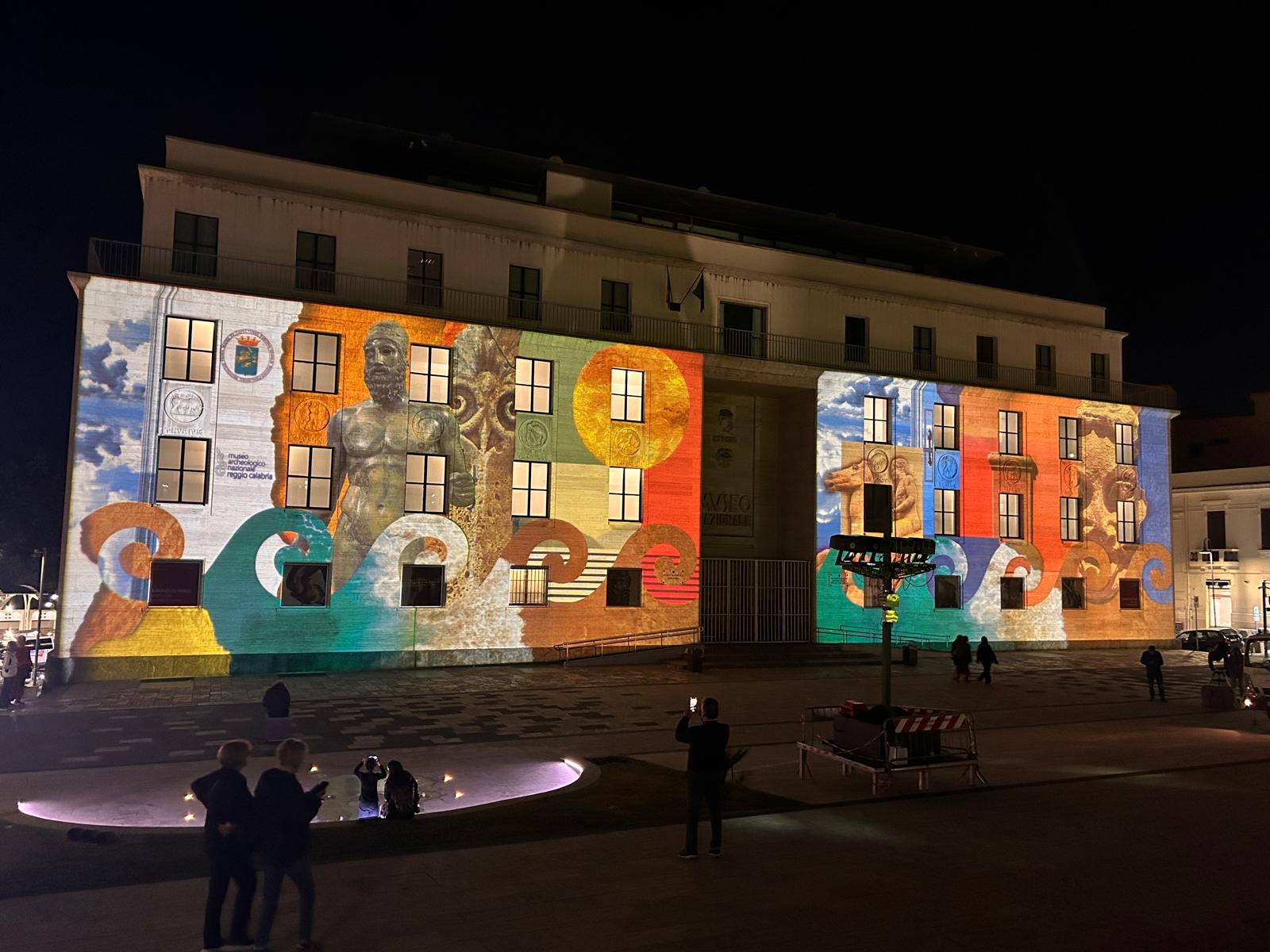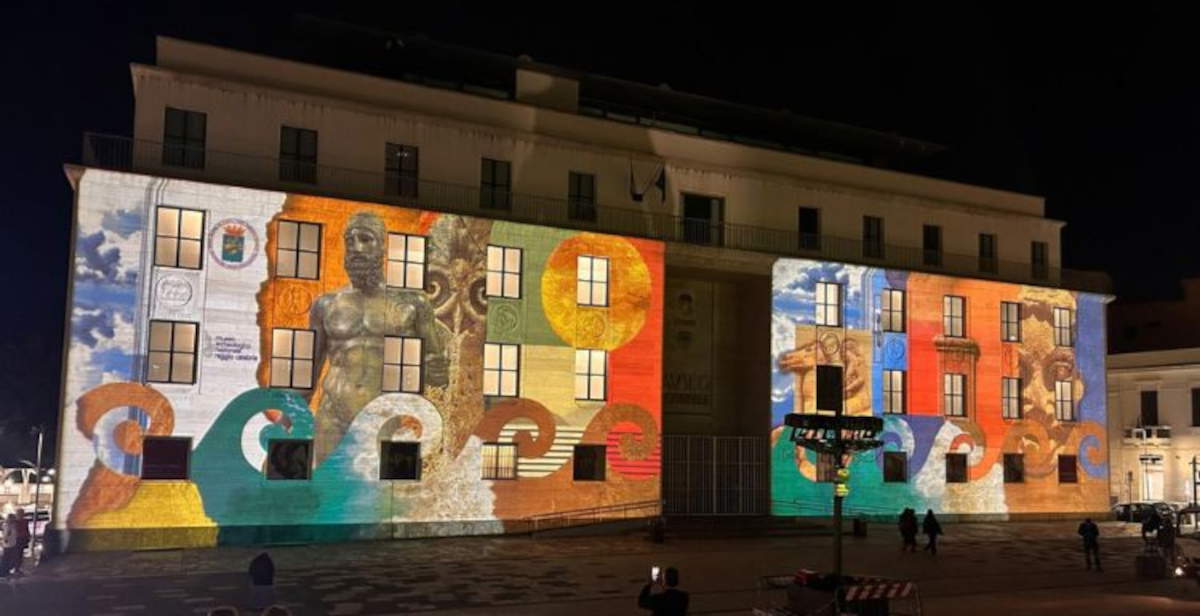In Reggio Calabria, the main façade of Palazzo Piacentini, home of the National Archaeological Museum, is transformed into an unprecedented light setting. The initiative is the result of a collaboration between the Museum’s management, the Municipality of Reggio Calabria and Goboservice, a company based in the city and active internationally in the production of architectural projectors and gobos. The project represents an innovative cultural enhancement intervention through light and technology. For the first time, the facade of the building hosts customized artistic projections that reproduce identity symbols of the heritage housed within the Museum. An intervention that combines artistic, technological and promotional purposes, configuring itself as a practice of public-private collaboration in the field of cultural and territorial promotion. The result is an evening visual experience, visible every evening until May 30, capable of putting the architecture of the Palace in dialogue with some of the most representative artifacts of the museum collection. Two batteries of high-definition projectors of the Divum 50k model, designed by Goboservice, have been placed in De Nava Square, overlooked by Palazzo Piacentini. The installations are the result of careful mapping of the building’s architectural surface, which allowed the projections to be adapted to its lines and volumes, enhancing the stylistic elements and original structure of the architecture.
The graphic design division of the Reggio Emilia-based company created visual content inspired by some of the National Archaeological Museum’s best-known and most significant artifacts. Among the projected images appear the Ionic column from the temple of Locri, the kouros from Rhegion, the female head found at the Caulonia site, a clay figurine depicting a dancer, the Knight of Marafioti, a terracotta gorgon, the Locrian pinakes and, of course, the Riace Bronzes. The two famous bronze statues found in 1972 represent one of the best-known symbols of the archaeological heritage of Calabria and Italy, and are the central element of the proposed visual narrative.

The initiative includes an extension of the project during the first days of June, coinciding with two major institutional events: Republic Day, June 2, and the day dedicated to the Carabinieri Corps, scheduled for June 5. On both occasions, the lighting sets will be enriched with new thematic content currently being developed. For the design of these additional visual contributions, Goboservice is collaborating with Abitalab, a laboratory of the Mediterranean University of Reggio Calabria. From June 6 to June 18, the facade of Palazzo Piacentini will once again host the summer art scene dedicated to the museum’s heritage, continuing a path of enhancement that has already begun. The intention is to keep open the dialogue between tradition and innovation, between archaeology and digital technologies, using light as a means to restore centrality to cultural places and to engage new audiences. The realization of the project saw the active participation of several local businesses. In addition to Goboservice, in fact, local companies that provided technical and logistical support collaborated on the installation, contributing to the success of the intervention.
The project is thus part of a broader strategy of promotion and enhancement of Calabria’s archaeological heritage, which in recent years has seen the National Archaeological Museum of Reggio Calabria consolidate its institutional role also through the adoption of technological tools for cultural dissemination. The intervention on Palazzo Piacentini represents a further development of this, acting directly on the urban space and the ways in which the museum relates to the city. The architectural lighting is distinguished by the coherence between the visual content and the architectural container. The projected images, selected from the artifacts actually kept inside the museum, restore narrative coherence to the intervention, overcoming the scenographic effect as an end in itself and transforming the façade into a storytelling and memory device. The direction taken appears to be oriented toward a strategic use of visual technologies applied to heritage communication, in a perspective that also aims at the dissemination and accessibility of cultural content. A process that, starting in Reggio Calabria, could suggest new paths for the relationship between museums and public space in the contemporary context.
“Celebrating our heritage with innovative tools means giving new life to history and making it an integral part of the city’s present,” said Fabrizio Sudano, director of the National Archaeological Museum of Reggio Calabria. “This project, the result of a virtuous synergy between the Museum, institutions and the entrepreneurial excellence of the area, represents a model of valorization that we hope can be replicated in the future. Seeing Palazzo Piacentini transformed every evening into a luminous narrative of our roots is an emotion we want to share with the entire community and visitors, reaffirming the Museum’s role as an open, dynamic space deeply connected to the cultural life of Reggio Calabria.”
“A truly spectacular light scenography,” says Reggio Calabria Mayor Giuseppe Falcomatà,“that recalls some of the most fascinating symbols of the city’s identity, interweaving our glorious history with contemporary digital tools that are absolutely projected into the future. The synergy between public and private once again produces a truly original and brilliant territorial promotion initiative, in this case brilliant precisely in the literal sense. Our beautiful De Nava Square, already the scene of important cultural initiatives, deserves to be fully enhanced. I thank Goboservice for this fine initiative and Director Fabrizio Sudano for his full willingness to collaborate, with institutions and with the territory, for a Museum that is increasingly open and integrated with the city and its community.”
 |
| A project transforms the facade of the Archaeological Museum of Reggio Calabria into a luminous setting |
Warning: the translation into English of the original Italian article was created using automatic tools. We undertake to review all articles, but we do not guarantee the total absence of inaccuracies in the translation due to the program. You can find the original by clicking on the ITA button. If you find any mistake,please contact us.